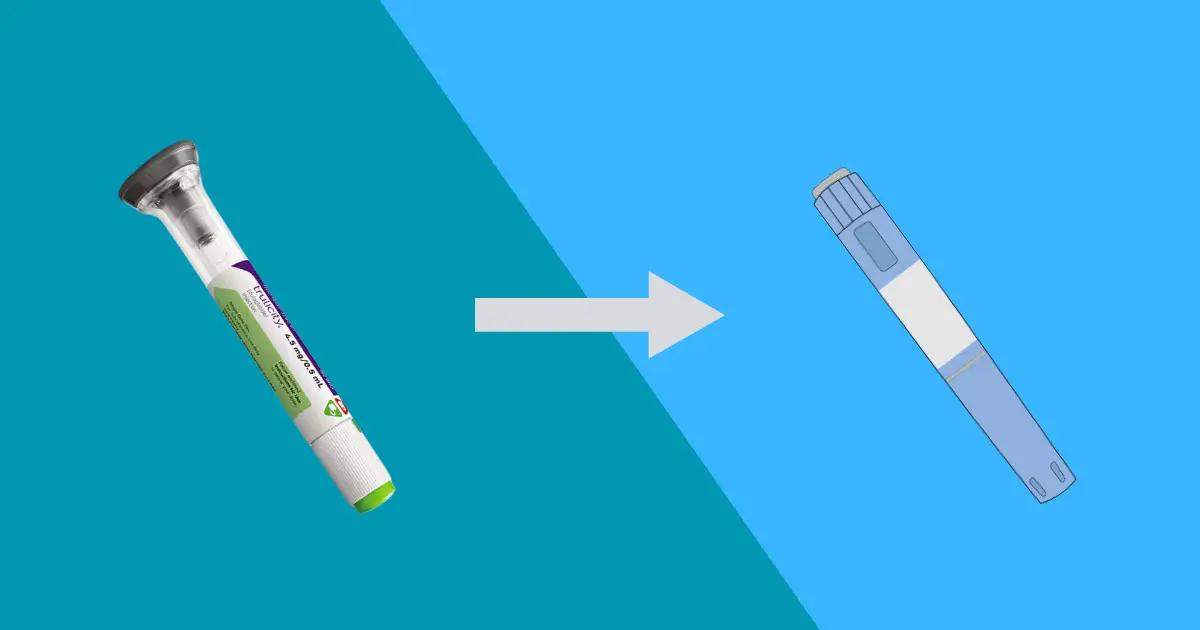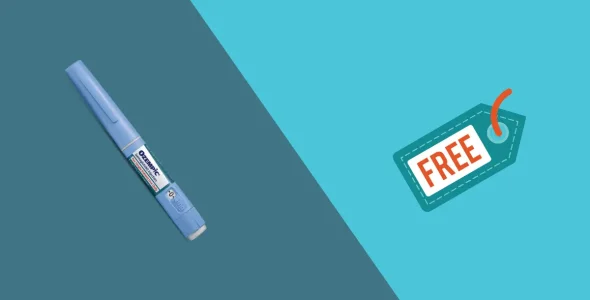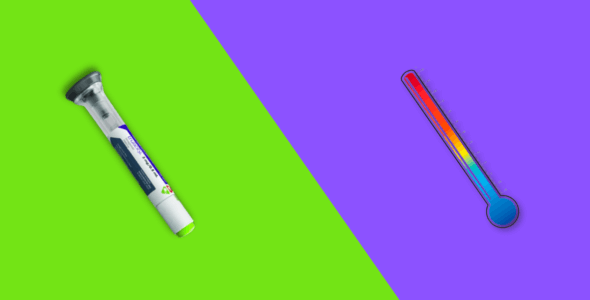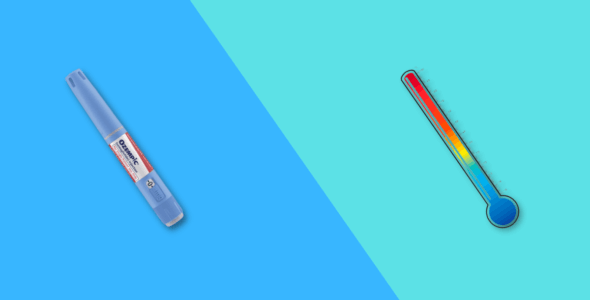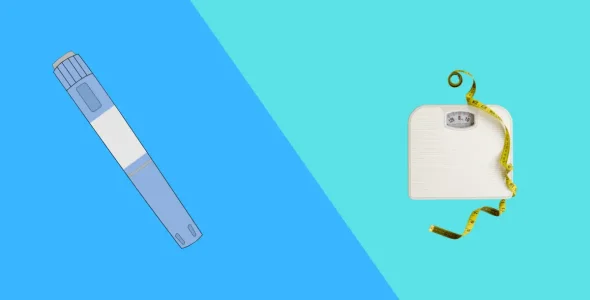Switching from Trulicity to Ozempic conversion chart
Thinking of switching from Trulicity to Ozempic? Compare effectiveness, side effects, dosing, and cost to make an informed decision.
Key highlights
- Trulicity and Ozempic are GLP-1 medications, both approved for managing blood glucose levels in patients with type 2 diabetes and reducing the risk of cardiovascular diseases.
- Clinical trials suggest that, despite the same mechanism of action, Ozempic is more effective than Trulicity in promoting glycemic control and weight loss (off-label).
- If your blood sugar levels are not controlled with Trulicity or you want to shed some extra pounds, Ozempic might be more suitable for you.
- There is no direct conversion chart for switching from Trulicity to Ozempic. Your doctor will recommend the dosage based on equivalent doses. Most healthcare providers suggest a step-down approach for starting Ozempic.
- Consult your healthcare provider if you want to make a switch. They will assess your current health condition and medical history and adjust your treatment plan accordingly.
Trulicity and Ozempic are once-weekly injectable GLP-1 receptor agonists. Both are popular for managing type 2 diabetes. Trulicity has dulaglutide as an active ingredient, and Ozempic is a brand-name medication containing the active ingredient semaglutide. Ozempic is FDA-approved for controlling blood sugar levels in type 2 diabetes, reducing the risk of blood and vessel-related problems, and lowering the risk of kidney failure in patients with chronic kidney disease (CKD) and type 2 diabetes. Trulicity is FDA-approved for improving glycemic control in type 2 diabetes mellitus patients and reducing the risk of cardiovascular events in patients with existing heart and blood vessel-related diseases or those who are at high risk of developing these conditions.
Due to growing popularity and greater benefits, many patients switch from Trulicity to Ozempic. Clinical studies suggest that semaglutide at both low and high doses is superior to dulaglutide in promoting blood sugar control and lowering body weight in patients with type 2 diabetes, who had a similar safety profile.
This article provides a detailed, step-by-step guide on safely and effectively switching from Trulicity to Ozempic, covering reasons for switching, dosage adjustments, potential benefits and risks, and what to expect during the transition.
Why consider switching from Trulicity to Ozempic?
The following are common reasons why healthcare providers might recommend switching from Trulicity to Ozempic:
Improved glycemic control
Semaglutide is more effective in improving glycemic control. In an open-label SUSTAIN 7 clinical trial published in the LANCET, 1,201 patients were randomly assigned to one of four treatment groups: semaglutide 0.5 mg (301 patients), dulaglutide 0.75 mg (299 patients), semaglutide 1.0 mg (300 patients), and dulaglutide 1.5 mg (299 patients). In terms of HbA1c reduction, semaglutide with a 0.5 mg dose achieved a reduction of 1.5% (vs. 1.1% with dulaglutide 0.75 mg). Semaglutide 1.0 mg resulted in a 1.8% reduction (vs. 1.4% with dulaglutide 1.5 mg). These results indicate that semaglutide was more effective than dulaglutide in reducing HbA1c levels at various doses.
Enhanced weight loss
Semaglutide (Ozempic) promotes greater weight reduction than dulaglutide (Trulicity). In the same clinical trial, semaglutide 0.5 mg led to a mean weight loss of 4.6 kg (vs. 2.3 kg with dulaglutide 0.75 mg). Semaglutide 1.0 mg showed an even greater reduction of 6.5 kg (vs. 3.0 kg with dulaglutide 1.5 mg).
Cardiovascular benefits
Ozempic is approved by the FDA for reducing the risk of major adverse cardiovascular events (MACE) in adults with type 2 diabetes and established heart disease. The medication offers potentially greater cardioprotection than Trulicity in patients who are at higher risk of developing cardiovascular diseases or those with existing heart and blood vessel-related health problems.
A clinical study compared the results of SUSTAIN 6 and REWIND studies to the effect of Ozempic vs. Trulicity on major adverse cardiovascular events such as non-fatal heart attack, non-fatal stroke, and death due to cardiovascular events. Semaglutide showed 26% greater reduction in heart and blood vessel-related diseases compared to dulaglutide (Trulicity).
Individualized response
Ozempic might be more effective for those patients who do not achieve significant improvement in their blood sugar levels or optimal glycemic control with Trulicity. The medication has greater efficacy than Trulicity for maintaining blood glucose levels.
Tolerability of side effects
Although the mechanism of action of both medications is the same, you may experience different side effects, depending on your body’s response to the medication. If you experience bothersome side effects from Trulicity, Ozempic might be a more tolerable option.
Insurance coverage and cost
If your insurance plan does not cover Trulicity, you can check with them if they cover Ozempic. Additionally, some insurance plans may have better coverage for Ozempic than Trulicity. In such cases, switching to Ozempic can make it a more financially viable option.
Both medications have a similar list price of about $1,000 per month and offer manufacturer savings cards to eligible individuals with commercial insurance coverage.
Patient preference
Dosing schedule and convenience of using devices can influence the choice of the medication. Some individuals may prefer a pre-filled pen or injections of Ozempic or the dosing schedule of Ozempic over Trulicity.
Understanding the key differences: Trulicity vs. Ozempic
Let’s review the key differences when comparing Trulicity vs. Ozempic:
Active ingredient
Trulicity has dulaglutide as its active ingredient, while Ozempic contains semaglutide. Both dulaglutide and semaglutide act as glucagon-like peptide-1 receptor agonists and have the same mechanism of action.
Efficacy
Ozempic is more effective than Trulicity. In the AWARD 11 trial, a 1 mg weekly dose of semaglutide (Ozempic) showed greater weight reduction than a 3 mg weekly dose of dulaglutide (Trulicity), with a mean difference of approximately 0.24% points. Changes in body weight were also more significant with a 1 mg weekly dose of semaglutide as compared to 3 mg and 4.5 mg of dulaglutide.
Various clinical studies show that Ozempic has a greater impact on weight reduction and blood sugar control.
Cardiovascular benefits
According to comparative research studies, Ozempic promotes a 26% greater reduction in cardiovascular events than Trulicity in adults with heart disease.
Dosage and administration
Ozempic is available in doses of 0.25 mg, 0.5 mg, 1 mg, and 2 mg. In comparison, available doses of Trulicity are 0.75 mg, 1.5 mg, 3 mg, and 4.5 mg per 0.5 ml solution.
The titration schedule of Ozempic is as follows:
- Weeks 1-4: 0.25 mg once weekly
- Weeks 5-8: 0.5 mg once weekly.
- Weeks 9-12 (if needed): 1 mg once weekly, if blood sugar levels are not controlled.
- Week 13 onwards (if needed): 2 mg once weekly, further blood sugar control is required, and your body can tolerate the previous doses.
The maintenance dose of Ozempic ranges from 0.5 mg to 2 mg per week. The maximum dosage is 2 mg weekly.
The titration schedule for Trulicity is as follows:
- Weeks 1-4: 0.75 mg once weekly
- Weeks 5-8: 1.5 mg once weekly.
- Weeks 9-12 (if needed): 3 mg once weekly, if blood sugar levels are not controlled.
- Week 13 onwards (if needed): 4.5 mg once weekly after at least 4 weeks on the previous dose.
The maintenance dose of Trulicity ranges between 0.75 mg and 4.5 mg. The maximum dosage is 4.5 mg, which is injected subcutaneously once weekly.
Side effect profiles
Both medications have similar potential side effects such as nausea, diarrhea, vomiting, abdominal discomfort and pain, decreased appetite, constipation and fatigue.
These side effects are usually transient and improve over time with lifestyle changes. However, they may worsen during dose escalation or at higher doses. Neither medication is suitable for patients with a history of pancreatitis, gallstones, gastroparesis, thyroid cell tumors such as medullary thyroid cancer (MTC) and MEN 2 syndrome. They may also worsen diabetic retinopathy.
FDA-approved uses
Although both medications are approved for type 2 diabetes patients, they have slightly different uses. Ozempic is indicated for lowering blood sugar levels and reducing the risk of cardiovascular events and worsening kidney disease or kidney failure (in chronic kidney disease) in adults with type 2 diabetes.
In comparison, Trulicity is approved for children 10 and older, adolescents, and adults for managing type 2 diabetes and reducing the risk of cardiovascular events.
Moreover, Ozempic is used off-label for weight management in obese and overweight adults.
Injection devices
Trulicity comes in a single-use, prefilled autoinjector pen. The device automatically delivers the full dose with the push of a button. Each pen can be used once and then discarded. In comparison, Ozempic comes in a multi-dose injection pen. Each pen contains several doses. You have to attach a new needle for each injection and select the dose using a dial. This pen can be reused by attaching a new needle each time.
Cost & insurance coverage
The list price of Ozempic is $997.58 for a 28-day supply. In comparison, the wholesale acquisition price of Trulicity is $987.19 per month.
Trulicity vs. Ozempic
| Ozempic | Trulicity | |
|---|---|---|
| Active Ingredient | Semaglutide | Dulaglutide |
| Form | Injectable solution | Injectable solution |
| Dosage | 0.25 mg, 0.5 mg, 1 mg, and 2 mg | 0.75 mg, 1.5 mg, 3 mg, and 4.5 mg |
| Starting Dose | 0.25 mg once weekly (Weeks 1–4) | 0.75 mg once weekly (Weeks 1–4) |
| Titration Schedule | Weeks 1–4: 0.25 mg once weekly Weeks 5–8: 0.5 mg once weekly Weeks 9–12: 1 mg once weekly (if needed) Weeks 13+: 2 mg once weekly (if needed) | Weeks 1–4: 0.75 mg once weekly Weeks 5–8: 1.5 mg once weekly Weeks 9–12: 3 mg once weekly (if needed) Weeks 13+: 4.5 mg once weekly (if needed) |
| Maintenance Dose | 0.5 mg to 2 mg once weekly | 0.75 mg to 4.5 mg once weekly |
| Maximum Dose | 2 mg once weekly | 4.5 mg once weekly |
| Frequency of Use | Once weekly injection | Once weekly injection |
| FDA Approval | Type 2 diabetes, cardiovascular risk reduction, lowering the risk of end stage kidney disease in adults | Type 2 diabetes and cardiovascular risk reduction in children aged 10 or more and adults |
| Effectiveness for HbA1c Reduction | May lower HbA1c more (up to 1.8%) | May lower HbA1c less (up to 1.4%) |
| Effectiveness for Weight Loss | More effective for weight loss (up to 15% of body weight) | Moderate weight loss (3-9%) |
| Kidney Health Benefits | Proven to reduce the risk of kidney disease-related events | No studies yet on kidney-related benefits |
| Maximum Dose | 2 mg once weekly | 4.5 mg once weekly |
| List price (Without Insurance) | $997.58 per month | $987.19 per month |
| Heart Disease Risk Reduction | Reduces major cardiovascular events by 26% in patients with cardiovascular disease | Reduces major cardiovascular events by 12% in patients with cardiovascular risk |
How to safely switch from Trulicity to Ozempic
Follow these steps for safely transitioning from Trulicity to Ozempic:
Consult your healthcare provider
Before switching any medication, consult your healthcare provider. Never stop taking Trulicity on your own. The switch between Trulicity and Ozempic is always done under medical supervision after your healthcare professional has assessed your health condition thoroughly. They will determine the most appropriate dosing schedule or treatment plan according to your blood sugar levels, body weight, comorbid conditions, and medical history.
Timing the switch
The general recommendation for switching the medication is to administer the first dose of Ozempic after at least 7 days of administering the last dose of Trulicity to maintain the consistent effects of GLP-1 medications on blood sugar levels and appetite.
For example, if you administered the last dose of Trulicity on Friday, you can administer the first dose of Ozempic on the next Friday.
Timing the switch from Trulicity to Ozempic
| Time since last dose of Trulicity | When to take first dose of Ozempic |
|---|---|
| Less than 7 days | Wait at least 7 days after your last Trulicity dose |
| 7–14 days | You may start any time within this window |
| 14 or more days | You can start today |
Determining the starting dose of Ozempic
Your doctor will determine the starting dose of Ozempic based on your current dose of Trulicity. They will suggest an equivalent dose. Generally, if you are taking 0.75 mg of Trulicity, your doctor will start Ozempic at 0.25 mg weekly. Similarly, a 1.5 mg weekly dose of Trulicity is considered equivalent to 0.5 mg of Ozempic, 3 mg to 1 mg of Ozempic, and 4.5 mg to 2 mg of Ozempic.
Most healthcare providers recommend a step-down approach for a safe switch and to reduce the risk of side effects. They recommend starting Ozempic at a low dose (0.25 mg once weekly for the first 4 weeks) for better tolerability.
Trulicity and Ozempic dose schedule comparisons
| Trulicity | Ozempic | |
|---|---|---|
| Starting Dose | 0.75 mg once weekly | 0.25 mg once weekly |
| Maintenance Dose | 1.5 mg – 4.5 mg once weekly | 0.5 mg – 2 mg once weekly |
| Maximum Dose | 4.5 mg once weekly | 2 mg once weekly |
Titration schedule for Ozempic
After the initial 4 weeks on a 0.25 mg weekly dose of Ozempic, the dosage of the medication is increased to 1 mg for the next 4 weeks.
Afterwards, if further glycemic control is required, your prescriber will increase the dosage to 2 mg weekly, which is the maximum dosage.
In case of any side effects, they will delay the dose increment for the next 4 weeks to give your body some time to adjust to the changes. After 4 weeks, they will reassess and adjust the dosage according to your blood sugar levels and the body’s tolerance.
Monitoring blood glucose levels
Strictly monitor blood sugar levels while switching to Ozempic, as this medication is more effective than Trulicity. You may experience low blood sugar levels, especially if you are taking it along with other diabetes medications like metformin, insulin (insulin glargine or lispro) and sulfonylureas.
Note down your fasting and post-prandial blood sugar levels daily and keep the record in an app or diary. If your blood sugar levels are not maintained, consult your doctor.
Managing potential side effects
GI side effects are common with GLP-1 receptor agonists. You can manage these side effects by following these tips:
- Eat smaller portions, practice portion control, but eat more frequently to avoid nausea.
- Eat bland, low-fat, and less greasy/oily foods.
- Add more proteins and dietary fibers to your diet.
- Over-the-counter remedies such as ginger tea can also help alleviate nausea and vomiting.
- Stay well hydrated, especially if you have vomiting and diarrhea.
- Consult your doctor for over-the-counter medications for nausea, vomiting, and diarrhea.
- Along with diabetes care, watch for signs of pancreatitis that include abdominal pain that radiates to the back, nausea, vomiting, and fever.
Awareness of hypoglycemia risk
Ozempic can cause low glucose levels. While taking the medication, look for the following signs of hypoglycemia:
- Sweating
- Shakiness
- Dizziness or lightheadedness
- Anxiety
- Slurred speech
- Lack of concentration
- Rapid heartbeat
- Irritability
- Mood changes
- Headache
- Tingling around the mouth and lips
- Blurred vision
In severe cases, hypoglycemia can cause loss of consciousness, seizures, or coma. If you feel your blood sugar levels are low, immediately consume fast-acting carbohydrates such as fruit juice, glucose tablets, honey, or sugar. Your blood sugar levels must be above 70 mg/dL. Inform your doctor about low blood sugar levels.
Diabetic retinopathy considerations
If you already have diabetic retinopathy, Ozempic may worsen it as the medication has the potential to cause changes in vision. To prevent these problems, inform your doctor before starting the medication and schedule regular follow-ups with your ophthalmologist for regular eye examination while taking the medication. Ask your doctor whether switching to Ozempic is suitable for you if you have diabetic retinopathy.
Doctor’s role
Consult your healthcare professional when:
- You experience severe side effects.
- Side effects are persistent and do not subside over time.
- You experience changes in vision, low blood sugar levels, or symptoms of pancreatitis and gallstones.
- Your surgery or any other procedure is scheduled that requires anesthesia and sedation.
- Your blood sugar levels are not maintained despite taking the medication regularly.
Trulicity to Ozempic dose conversion chart
There is no direct dose conversion chart for switching from Trulicity to Ozempic. The following is a general conversion chart based on equivalent doses.
Trulicity to Ozempic dose conversion chart
| Trulicity dose | Equivalent Ozempic dose |
|---|---|
| - | 0.25 mg |
| 0.75 mg | - |
| 1.5 mg | 0.5 mg |
| 3 mg | 1 mg |
| 4.5 mg | 2 mg |
It is important to remember that these are general guidelines and conversion charts. Dosage regimens for individuals may be different based on their conditions and risk factors.
What to expect during the transition: Potential benefits and risks
You can expect the following benefits and risks while switching from Trulicity to Ozempic:
Improved blood sugar control
Ozempic (semaglutide) has shown greater glycated hemoglobin A1c reduction compared to Trulicity in some studies. The medication promotes glycemic control more effectively, especially for patients who did not maintain blood sugar levels with Trulicity.
Greater weight loss
Patients switching to Ozempic often experience more significant weight reduction. Clinical studies suggest that patients using semaglutide (Ozempic) lost 5-15% of their body weight, compared to 3–9% with Trulicity.
Cardiovascular risk reduction
Ozempic has demonstrated a 26% reduction in major cardiovascular events in patients with existing cardiovascular disease compared to placebo. In contrast, Trulicity showed a 12% reduction in cardiovascular events. If you have any heart disease or you are at high risk of developing cardiovascular diseases, Ozempic may provide you with added protection beyond blood sugar control.
Flexible dosing options
Like Trulicity, Ozempic has multiple doses ranging between 0.25 mg and 2 mg, which allows for individualized titration based on your blood sugar levels, body’s tolerability, and weight loss goals.
Potential risks and considerations
Gastrointestinal side effects
Like Trulicity, Ozempic can cause gastrointestinal adverse effects such as nausea, vomiting, diarrhea, abdominal discomfort, and constipation, especially during a dose increment. However, the severity of side effects may differ from person to person. Some patients report more tolerable GI effects on one medication compared to others.
Risk of hypoglycemia
As Ozempic is more effective than Trulicity, it may cause hypoglycemia. Although the risk for hypoglycemia is low, it may occur especially when you use the medication with sulfonylureas or insulin. Closely monitor your side effects and consult your doctor for dose adjustments, if required.
Diabetic retinopathy warning
Ozempic carries a specific warning about a possible risk of worsening diabetic retinopathy. This is especially for those patients who have pre-existing diabetic retinopathy. Regular eye exams and careful blood sugar monitoring can prevent this problem.
Individual variability in response
Not all patients respond the same way to Ozempic. There is a possibility that you may notice minor differences or may not tolerate the switch very well. Monitoring symptoms and blood glucose during the transition is critical to ensure effectiveness and safety.
Insurance and access
Some insurance plans may cover Ozempic more favorably than Trulicity, while others may not, depending on your insurance plan and deductibles. It is recommended to verify with your insurance provider whether your insurance plans cover Ozempic before making the switch.
Potential side effects and how to manage them
Common side effects of Ozempic are typically transient and subside without any treatment. Serious side effects rarely occur but usually need medical attention for proper management.
Common side effects
The common side effects may be stronger with Ozempic as compared to Trulicity. These include:
- Nausea
- Diarrhea
- Abdominal pain/discomfort
- Stomach pain
- Vomiting
Rare but serious risks
- Pancreatitis
- Changes in vision
- Gallstones
- Injection site reactions
- Severe stomachache
- Excessive burping
- Mood and behaviour changes
- Suicidal ideation
- Hypoglycemia
- Allergic reaction
- High risk of aspiration during surgical procedures that require anesthesia or sedation
Some rodent studies show that GLP-1 medications increase the risk of thyroid cancer. The medication has a boxed warning for patients with a personal or family history of medullary thyroid cancer and Multiple endocrine neoplasia type 2 syndrome (MEN 2 syndrome).
Do not take Ozempic if you are breastfeeding, pregnant, or planning to conceive. The medication can not be taken along with oral contraceptives and supplements. Inform your doctor in these cases for better guidance.
Tips to reduce side effects
- Start Ozempic at a lower dose with a step-down approach for making a safe switch. The initial dose (0.25 mg) is very low; it can help test your body’s response and assess tolerability.
- Increase the dosage slowly and gradually as recommended by your healthcare provider. Do not escalate Ozempic dosage too quickly, as it can lead to intolerable side effects.
- Do not lie down immediately after having a meal. Stay active and walk for at least 20-30 minutes daily for better digestion.
- Avoid oily, processed, high-fat meals to lower the risk of nausea and vomiting.
- Eat healthy, hygienic, and low-fat foods, especially those rich in dietary fibers.
- Stay hydrated and sleep for at least 7-8 hours daily at night. Healthy habits complement the effect of weight loss medications and reduce the risk of side effects.
Cost and insurance coverage
The List price of Ozempic is $997.58 per month compared to $987.19 for a monthly supply of Trulicity. According to GoodRx, the average retail price of Ozempic is $1,101.96 per month and $1,181.28 for Trulicity.
According to GoodRx, the list prices are as follows:
Ozempic vs. Trulicity price comparison
| Pharmacy | Ozempic | Trulicity |
|---|---|---|
| Walgreens | $995 | $1,020 |
| Walmart | $995 | $1,031 |
| CVS Pharmacy | $995 | $1,019 |
| Costco | $965 | $1,094 |
Most private insurance companies, such as Blue Cross Blue Shield, Aetna, United Healthcare, and Cigna, cover Ozempic for type 2 diabetes. However, insurance companies do not cover Ozempic when the medication is used solely for weight management (off-label).
Medicare insurance plans also cover Ozempic for its FDA-approved indications. However, Medicaid’s coverage for Ozempic varies among different states. You can confirm whether Ozmepic is listed in your state’s Medicaid formulary.
Novo Nordisk offers an Ozempic savings card for patients with commercial or private insurance that includes Ozempic coverage. This card allows eligible users to access a 1-, 2-, or 3-month supply of Ozempic for as little as $25. The offer is valid for up to 48 months and requires a valid prescription from a licensed healthcare provider. To qualify, you must fulfil the following conditions:
- You must be a U.S. resident.
- You must be at least 18 years old.
- You should have a valid prescription for Ozempic for an FDA-approved indication (type 2 diabetes, cardiovascular risk reduction, or prevention of kidney failure) from a licensed healthcare professional.
- You are not enrolled in government or state-sponsored insurance programs such as Medicare, Medicaid, TRICARE, VA, DOD, or Medigap.
Several online pharmacy platforms offer coupon cards that can reduce the cost of Ozempic by 9% to 27%. You can check the following websites to access available discount cards:
- GoodRx
- WellRx
- BuzzRx
- SingleCare
- Optum Perks
Lifestyle management during and after the switch
If you are planning to transition from Ozempic to Trulicity, remember that lifestyle modifications play a key role in achieving desired results. A healthy lifestyle helps improve blood sugar control, promotes weight loss, and minimizes the risk of side effects.
Healthy and balanced diet
- Consume a balanced, nutrient-rich, and low-fat diet with a low glycemic index, like vegetables, lean proteins, whole grains, and healthy fats.
- Add protein-rich foods such as lentils, legumes, peas, fish, white poultry, and Greek yogurt to preserve your muscle mass.
- Consume whole carbohydrates such as whole grains instead of refined sugars to help stabilize blood sugar levels.
- If you need personalized guidance, consult a registered dietitian or nutritionist.
Regular exercise
Exercise daily for at least 60 minutes. You can include moderate-intensity physical activity such as walking, cycling, swimming, jogging, resistance training, cardio, and yoga in your routine. Physical activity and regular exercise improve basal insulin sensitivity, support weight loss, and help lower glycated hemoglobin HbA1c levels.
Hydration
Stay well-hydrated, especially when you start taking any GLP-1 medication. They can cause gastrointestinal side effects such as nausea, vomiting, and diarrhea, which can lead to dehydration. Severe dehydration can result in acute kidney injury. Drink water consistently throughout the day to keep your body well hydrated.
Avoid coffee, sugary beverages, and alcohol that cause dehydration.
Regular follow-ups with your provider
Regular follow-ups with your healthcare professional (who has clinical experience in GLP-1 medications) are necessary for proper dose titrations, monitoring side effects, tracking blood sugar levels, and making lifestyle adjustments.
Consult your doctor before making a switch, and stay in contact with them during the transition phase to safely switch from Trulicity to Ozempic. In case of side effects, do not administer the next dosage before consulting your doctor. You can also discuss other options like tirzepatide (Mounjaro and Zepbound, which are GLP-1 and GIP receptor agonists), liraglutide (Victoza), semaglutide (Wegovy and Rybelsus), Bydureon, and Byetta (Exenatide).
FAQs about switching from Trulicity to Ozempic
Can I switch directly from Trulicity to Ozempic?
No, you cannot switch directly from Trulicity to Ozempic. There is no direct conversion chart. Consult your healthcare provider before switching these medications. They will calculate equivalent doses and recommend the most suitable dosage according to your condition.
Will I lose more weight with Ozempic?
You may lose more weight with Ozempic if using it in combination with a healthy lifestyle. Clinical studies suggest that Ozempic has a greater potential for weight reduction. In SUSTAIN 7 clinical trials, 0.5 mg Ozempis reduced 4.6 kg body weight compared to 2.3 kg with 0.75 mg Trulicity. However, individual responses may vary.
Does Ozempic work faster than Trulicity?
Ozempic may not work faster than Trulicity, but the medication works more effectively than Trulicity. It can promote greater weight loss or help achieve optimal glycemic control in the same timeframe as compared to Trulicity.
What if my insurance doesn’t cover Ozempic?
If your insurance does not cover Ozempic, you can submit an appeal to your insurance company. You can also use pharmacy discount cards to save 9 to 27% on Ozempic. Consult your doctor to discuss whether it is a suitable choice for you.
Conclusion: Safely switching from Trulicity to Ozempic
Ozempic and Trulicity are GLP-1 medications with the same mechanism of action but different active ingredients. If you are taking Trulicity and your blood sugar levels or HbA1c are not maintained despite taking the medication regularly, or you want to reduce your body weight, Ozempic might be a better choice for you.
However, if your blood sugar levels are well maintained and your insurance covers Trulicity, it is better to stick to Trulicity than switch to Ozempic.
Do not stop taking any GLP-1 medication before consulting your doctor. If you plan to make a switch, consult your healthcare provider first. They will assess your blood sugar levels, HbA1c, body weight, and previous medical records. Afterwards, they will choose the most suitable medication based on your goals, medical history, and potential risks and benefits.
Always have open communication with your doctor throughout the transition process. Note down your questions and concerns and discuss them with your healthcare provider.
